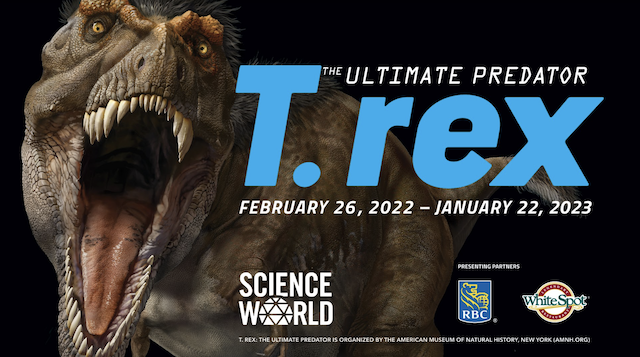T.Rex: The Ultimate Predator at Science World
Encounter the prehistoric wonders of the late Cretaceous Period and come face-to-face with a 66-million-year-old marvel with T.Rex: The Ultimate Predator at Science World. Get to know the entire tyrannosaur family, and reveal the amazing story of the most iconic dinosaur in the world through life-sized models, fossil casts, and engaging interactive displays.
Everyone knows Tyrannosaurus rex. But did you know that T. rex hatchlings were fluffy and gangly, more like turkeys than the massive killing machines they grew up to be? Or that T. rex evolved from a large group of dinosaurs that were, for the most part, small, and fast? Or how about that the mega- predator had the rare ability to pulverize and partially digest bones?
T.Rex: The Ultimate Predator at Science World
- When: February 26, 2022 to January 22, 2023
- Where: Science World (1455 Quebec St, Vancouver)
- Tickets: Available online now
Visitors to T. rex: The Ultimate Predator will encounter a massive life-sized model of a T. rex with patches of feathers—the definitive representation of this prehistoric predator. The exhibition will also include reconstructions of a T. rex hatchling and a four-year-old juvenile T. rex; a “roar mixer” where visitors can imagine what T. rex may have sounded like by blending sounds from other animals; a shadow theater featuring a floor projection of an adult T. rex skeleton coming to life; and a life-sized animation of T. rex in a Cretaceous environment that responds to visitors’ movements.
In this exhibition visitors can expect to engage with:
- Life-size models of a number of tyrannosaurs, including: Proceratosaurus bradleyi
- A cast fossil of a T. rex toe bone and a touchable cast of a T. rex thigh bone
- A cast of the youngest and most complete juvenile tyrannosaur fossil found to date
- A cast fossil of one of T. rex’s huge, banana-shaped teeth,
- A tabletop “Investigation Station,” where visitors can explore a variety of fossil casts ranging from coprolite (fossilized feces) to a gigantic femur, with virtual tools including a CT scanner, measuring tape, and a microscope to learn more about what such specimens can reveal to scientists about the biology and behavior of T. rex.
- A full-scale reproduction of a T. rex fossil skeleton, the subject of the exhibition’s “shadow theater,” in which the skeleton’s 40-foot shadow will “come to life” and demonstrate to visitors how the animal moved and interacted with prey and its own kind.
- A praxinoscope that animates the difference between walking and running—T. rex could only truly run when it was young.
This exhibition encourages visitors to engage in investigation with imagination and explore how the Tyrannosaurus rex may have looked and behaved over 66 million years ago. As visitors tour the gallery, they’ll examine the T. rex in all stages of its life, from a young, furry baby, to a massive, fully grown apex predator through its 100 million years of evolution. All the while, new technologies, ways of thinking and recent discoveries will encourage visitors to observe clues, ask questions and test new hypotheses, challenging what you thought you knew about these creatures.










